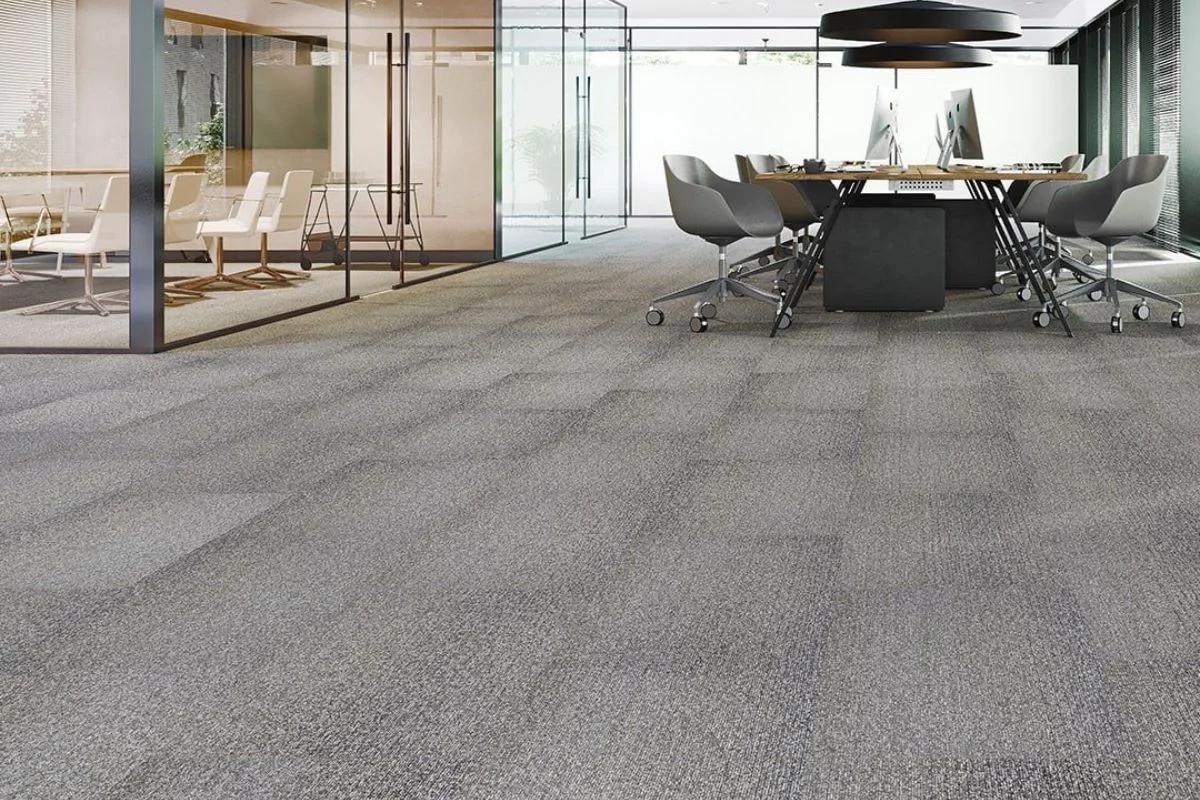In the ever-evolving landscape of modern workplaces, the importance of functional and aesthetically pleasing design cannot be overstated. Among the myriad of design choices available to office managers and interior designers, carpet tiles have emerged as a practical and versatile solution for flooring needs. These modular floor coverings offer a multitude of benefits that align perfectly with the demands of contemporary workspaces.
Gone are the days of monotonous, uninspiring office environments. Today, businesses prioritize creating spaces that foster productivity, collaboration, and employee well-being. In this context, office carpet tiles have risen in popularity due to their unique combination of functionality, durability, and design versatility.
In this exploration, we will delve into the numerous advantages that office carpet tiles bring to modern workspaces. From their ease of installation and maintenance to their ability to enhance acoustics and aesthetics, we will uncover why carpet tiles have become the go-to choice for businesses striving to create efficient, attractive, and adaptable office environments. Join us as we navigate through the benefits of office carpet tiles and discover why they are indeed a practical solution for the demands of today’s workplaces.
Definition and characteristics of office carpet tiles
Office carpet tiles, also known as carpet squares or modular carpeting, are individual sections of carpeting material that are designed specifically for use in office environments. Unlike traditional broadloom carpeting, which comes in large rolls, office carpet tiles are typically square or rectangular in shape and come in standardized sizes, such as 18 inches by 18 inches or 24 inches by 24 inches.
Here are some key characteristics of office carpet tiles:
Modular Design: Office carpet tiles feature a modular design, which means they are manufactured as individual units that can be installed and replaced independently. This modular nature offers flexibility in terms of installation, maintenance, and design options.
Diverse Materials: Office carpet tiles are available in a variety of materials, including nylon, polyester, polypropylene (olefin), and wool. Each material offers different characteristics in terms of durability, stain resistance, and texture, allowing businesses to choose the option that best suits their needs and budget.
Versatile Designs: Carpet tiles come in a wide range of designs, patterns, and colors, allowing businesses to customize their office spaces according to their brand identity and aesthetic preferences. From solid colors to intricate patterns, there are options available to suit every design scheme.
Ease of Installation: Installing office carpet tiles is typically easier and faster compared to traditional carpeting. They can be installed using different methods, including adhesive backing, interlocking systems, or glue-down installation, depending on the manufacturer and the type of subfloor.
Durability: Office carpet tiles are designed to withstand the rigors of commercial environments, including heavy foot traffic, rolling office chairs, and frequent cleaning. They are constructed with durable materials and reinforced backing to ensure longevity and performance.
Sound Absorption: Carpet tiles offer excellent sound absorption properties, helping to reduce noise levels in busy office environments. This acoustic insulation creates a quieter and more conducive workspace, improving productivity and concentration among employees.
Maintenance: Carpet tiles are relatively easy to maintain compared to traditional carpeting. Spills and stains can be spot-cleaned using mild detergent solutions, and individual tiles can be replaced if they become damaged or worn over time.
Sustainability: Many manufacturers offer eco-friendly options for office carpet tiles, including recycled materials and low-VOC adhesives. These sustainable choices help businesses reduce their environmental footprint while still enjoying the benefits of quality flooring.
Benefits of Using Carpet Tiles in Office Spaces
Using carpet tiles in office spaces offers numerous benefits that cater to the needs of modern workplaces. Here are some key advantages:
Design Flexibility: Carpet tiles come in a wide range of designs, colors, and patterns, allowing businesses to create unique and customized flooring solutions that reflect their brand identity and corporate culture. From classic neutrals to vibrant hues, the design options are virtually limitless, enabling businesses to tailor their office aesthetics to suit their preferences.
Ease of Installation: Unlike traditional broadloom carpeting, which requires professional installation and often involves lengthy downtime, carpet tiles are relatively easy to install. They can be laid out quickly using various methods such as adhesive backing, interlocking systems, or glue-down installation. This ease of installation minimizes disruption to the workplace and allows for swift updates or replacements as needed.
Modular Versatility: One of the most significant advantages of carpet tiles is their modular nature. Each tile functions as an individual unit, making it simple to replace damaged or stained tiles without having to redo the entire floor. This modularity also enables businesses to experiment with different layouts, patterns, and configurations to achieve unique and dynamic design effects.
Durability and Longevity: Carpet tiles are engineered to withstand the rigors of commercial environments, including heavy foot traffic, rolling office chairs, and frequent cleaning. They are constructed with durable materials and reinforced backing to ensure longevity and performance, making them an excellent investment for businesses seeking a long-term flooring solution.
Sound Absorption: Office environments can be noisy, with sounds from conversations, phone calls, and office equipment contributing to distractions and reduced productivity. Carpet tiles offer excellent sound absorption properties, helping to minimize noise levels and create a quieter and more conducive workspace. This acoustic insulation promotes concentration and enhances the overall comfort of employees.
Comfort Underfoot: The cushioned texture of carpet tiles provides a comfortable surface underfoot, making long hours of standing or walking more bearable for employees. Unlike hard flooring materials such as tile or hardwood, carpet tiles offer a softer and more supportive surface, reducing fatigue and discomfort during the workday.
Safety Features: Many carpet tiles come with built-in safety features such as non-slip backing, which helps to prevent slips, trips, and falls in the workplace. This is particularly important in high-traffic areas or environments where spills and moisture are common. Additionally, carpet tiles can provide an extra layer of insulation against electrical shocks, enhancing overall safety in the office.
Easy Maintenance: Maintaining carpet tiles is relatively simple and cost-effective compared to other flooring options. Spills and stains can be spot-cleaned using mild detergent solutions, and individual tiles can be replaced if they become damaged or worn over time. Routine vacuuming and occasional deep cleaning help to keep the carpet tiles looking fresh and vibrant for years to come.
Environmental Sustainability: Many manufacturers offer eco-friendly options for carpet tiles, including recycled materials and low-VOC adhesives. By choosing sustainable flooring solutions, businesses can reduce their environmental footprint and contribute to a healthier planet. Additionally, the modular design of carpet tiles minimizes waste during installation and replacement, making them a sustainable choice for eco-conscious organizations.
Environmental Impact of Office Carpet Tiles
The environmental impact of office carpet tiles is a multifaceted issue that encompasses various aspects of production, usage, and disposal. While carpet tiles offer numerous benefits for office environments, including durability, design flexibility, and ease of maintenance, their lifecycle can have significant implications for the environment.
Manufacturing Processes: The production of office carpet tiles involves energy-intensive manufacturing processes that consume raw materials, water, and energy. The extraction of resources, such as petroleum-based fibers like nylon or polyester, contributes to environmental degradation through habitat destruction, air and water pollution, and greenhouse gas emissions.
Resource Consumption: Office carpet tiles require significant quantities of resources during manufacturing, including energy, water, and chemicals. The production of synthetic fibers and backing materials involves the use of non-renewable resources and the release of pollutants into the environment. Additionally, the transportation of raw materials and finished products further contributes to resource consumption and carbon emissions.
Waste Generation: Office carpet tiles have a finite lifespan and eventually require replacement due to wear and tear, damage, or changes in design preferences. The disposal of old or worn-out carpet tiles can pose environmental challenges, as they often end up in landfills where they contribute to solid waste accumulation and take years to decompose. In some cases, incineration of carpet tiles may release harmful emissions into the atmosphere.
Chemical Exposure: Office carpet tiles may contain harmful chemicals such as volatile organic compounds (VOCs), flame retardants, and adhesives, which can off-gas into the indoor environment and impact indoor air quality. Prolonged exposure to these chemicals can pose health risks for building occupants, including respiratory issues, allergies, and other adverse health effects.
End-of-Life Management: Proper disposal and recycling of office carpet tiles are essential considerations for minimizing environmental impact. Recycling programs and initiatives can divert old carpet tiles from landfills and facilitate the recovery of valuable materials for reuse or repurposing. However, recycling infrastructure and availability may vary depending on location and market demand.
Despite these environmental challenges, there are steps that businesses can take to mitigate the environmental impact of office carpet tiles:
Choose Sustainable Materials: Opt for office carpet tiles made from eco-friendly materials such as recycled fibers, natural fibers, or renewable resources. Look for products certified by third-party organizations for their environmental performance, such as the Carpet and Rug Institute’s Green Label or Cradle to Cradle certification.
Reduce Waste: Minimize waste during installation and replacement by carefully planning layout designs and optimizing material usage. Consider reusing or repurposing old carpet tiles in other applications or donating them to organizations in need.
Implement Proper Maintenance: Regular maintenance and cleaning of office carpet tiles can prolong their lifespan and reduce the need for premature replacement. Implement sustainable cleaning practices using eco-friendly detergents and equipment, and address spills and stains promptly to prevent permanent damage.
Support Recycling Initiatives: Advocate for recycling programs and initiatives that promote the responsible disposal and recycling of office carpet tiles. Work with manufacturers and suppliers that offer take-back programs or recycling services for end-of-life carpet tiles.
Installation Process of Office Carpet Tiles
The installation process of office carpet tiles is a critical aspect of achieving a professional and durable flooring solution. Unlike traditional broadloom carpeting, which comes in large rolls and requires extensive installation expertise, carpet tiles offer a more manageable and flexible approach to flooring installation. Here’s a step-by-step guide to the installation process of office carpet tiles:
Surface Preparation: Before installing carpet tiles, it’s essential to prepare the subfloor properly. Ensure that the subfloor is clean, dry, and level. Remove any debris, dust, or adhesive residues that may interfere with the installation process. Repair any cracks, holes, or uneven areas in the subfloor to create a smooth and stable surface for the carpet tiles.
Layout Planning: Plan the layout of the carpet tiles to optimize the use of materials and achieve the desired design aesthetic. Consider factors such as room dimensions, traffic patterns, and directional flow when laying out the tiles. Use chalk lines or markers to establish guidelines for accurate tile placement and alignment.
Adhesive Application: Depending on the type of carpet tiles and subfloor conditions, you may need to apply adhesive to secure the tiles in place. Choose a high-quality adhesive recommended by the manufacturer for optimal bonding strength and durability. Follow the manufacturer’s instructions for proper adhesive application, including coverage rates, drying times, and application techniques.
Tile Installation: Begin the tile installation process in one corner of the room, working outward in a grid-like pattern. Peel off the protective backing from the first carpet tile and carefully position it at the starting point, aligning the edges with the layout guidelines. Press down firmly on the tile to ensure proper adhesion to the subfloor. Repeat the process, working row by row, and ensure tight seams and uniform spacing between tiles.
Cutting and Trimming: As you reach the perimeter of the room or encounter obstacles such as walls, doorways, or columns, you may need to cut and trim the carpet tiles to fit. Use a utility knife or carpet cutter to make precise cuts along the edges of the tiles, ensuring a seamless transition between tiles and a snug fit against walls or obstacles. Take accurate measurements and use a straightedge or template for precise cutting.
Seam Alignment: Pay close attention to seam alignment and pattern matching to achieve a cohesive and professional-looking installation. Align the pattern or grain of the carpet tiles consistently throughout the room to maintain visual continuity and aesthetic appeal. Adjust tile placement as needed to ensure seamless transitions between rows and minimize visible seams.
Final Inspection and Cleaning: Once all carpet tiles are installed, perform a final inspection of the flooring to ensure proper alignment, adhesion, and appearance. Check for any loose or misaligned tiles and make adjustments as necessary. Clean the surface of the carpet tiles to remove any adhesive residues, dust, or debris using a vacuum cleaner or damp mop. Allow the adhesive to cure fully according to the manufacturer’s recommendations before allowing foot traffic on the newly installed carpet tiles.
Furniture Replacement: After the carpet tile installation is complete and the adhesive has cured, replace furniture, equipment, and fixtures in the room. Use furniture glides or protective pads to prevent indentation marks and damage to the carpet tiles. Avoid heavy rolling loads or sharp objects that may cause damage to the flooring surface.
Maintenance Tips for Office Carpet Tiles
Maintaining office carpet tiles is essential to preserve their appearance, functionality, and longevity. With proper care and maintenance, office carpet tiles can retain their aesthetic appeal and performance for years to come. Here are some maintenance tips for office carpet tiles:
Regular Vacuuming: Implement a routine vacuuming schedule to remove dirt, dust, and debris from the surface of the carpet tiles. Use a high-quality vacuum cleaner equipped with a beater bar or brush attachment to effectively lift and remove soil particles from the carpet fibers. Vacuum the entire floor area, including high-traffic areas, corners, and edges, at least once or twice a week to prevent soil buildup.
Prompt Spot Cleaning: Attend to spills and stains immediately to prevent them from setting into the carpet fibers. Blot the affected area with a clean, absorbent cloth or paper towel to absorb excess liquid. Avoid rubbing the stain, as it can spread and penetrate deeper into the carpet. Use a mild detergent solution or carpet stain remover according to manufacturer instructions, and blot again until the stain is lifted.
Deep Cleaning: Schedule periodic deep cleaning sessions to remove embedded dirt, stains, and allergens from the carpet tiles. Depending on the level of soiling and foot traffic, deep cleaning may be required every 6 to 12 months. Consider hiring a professional carpet cleaning service equipped with steam cleaning or hot water extraction equipment to achieve thorough and effective cleaning results.
Use Entrance Mats: Place entrance mats or walk-off mats at entryways to trap dirt, moisture, and debris before they reach the office carpet tiles. This helps minimize soil accumulation and reduces the need for frequent cleaning and maintenance. Choose durable and absorbent mats that can withstand heavy foot traffic and effectively capture contaminants from shoes.
Rotate Furniture: Regularly rearrange furniture and office equipment to distribute weight evenly and prevent permanent indentations or wear patterns on the carpet tiles. Use furniture glides or casters to minimize friction and protect the carpet fibers. Consider using furniture pads or coasters under heavy furniture legs to prevent damage to the flooring surface.
Preventive Maintenance: Implement preventive maintenance measures to protect the carpet tiles from damage and wear. Use chair mats under rolling office chairs to prevent excessive wear and tear on the carpet surface. Encourage employees to remove their shoes or wear clean indoor footwear to minimize soil accumulation and reduce the risk of staining.
Address Odors: If you notice any unpleasant odors emanating from the carpet tiles, identify and eliminate the source promptly. Use carpet deodorizers or baking soda to neutralize odors, and ensure adequate ventilation to promote air circulation and freshness. Consider using natural odor-absorbing materials such as activated charcoal or citrus-based air fresheners.
Inspect Regularly: Conduct regular inspections of the carpet tiles for signs of wear and tear, loose seams, or damaged tiles. Address any issues promptly to prevent further damage and prolong the lifespan of the flooring. Replace damaged or worn-out carpet tiles as needed to maintain a uniform and aesthetically pleasing appearance.
conclusion
In conclusion, the maintenance of office carpet tiles is crucial for preserving the appearance, functionality, and longevity of the flooring in commercial environments. By implementing a proactive approach to maintenance, businesses can ensure that their office spaces remain clean, attractive, and conducive to productivity.







